Curio repens
Curio repens (L.) P.V.Heath
Family: Asteraceae
Common names: blue toes (Eng.); kransharpuis, bloutoontjies (Afr.)
Introduction
Curio repens is a low, cluster-forming to drooping, leaf and stem succulent perennial from sandstone cliffs and rocky parts of the Cape Peninsula to Hermanus. The leaves, often crowded at the branch ends, are striking bluish pale green and have a resinous smell when damaged. Easily grown from cuttings or and best for dry, warm, Fynbos and Mediterranean gardens.

Description
Description
Sprawling, branched succulent shrublets forming loose mats. The branches are decumbent to sub-pendent, smooth, hairless, rooting at nodes, often stoloniferous from the base. Roots fibrous. Branches are terete, succulent, up to 200 mm long; young branches flaccid, tapering, pruinose, becoming green and eventually grey and torulose (constricted at intervals), the mature stems are 5–9 mm in diameter, covered in old leaf scars. Leaves ascending to ascending spreading, variable in shape and size, somewhat crowded towards the end of the branches, dorsoventrally flattened, boat-shaped (cymbiform), upper surface concave, with the central vein translucent. The leaf blade is highly succulent becoming somewhat rounded when turgid, elliptic to linear-elliptic or linear-obovate to obovate, 20–35 × 9–12 mm. The margin is entire; surface bluish green because of a powdery bloom, becoming purplish during prolonged dry conditions (densely pruinose), both surfaces with 8–19 translucent veins, lower surface rounded; apex obtuse to acute, mucronate, brownish to purplish.
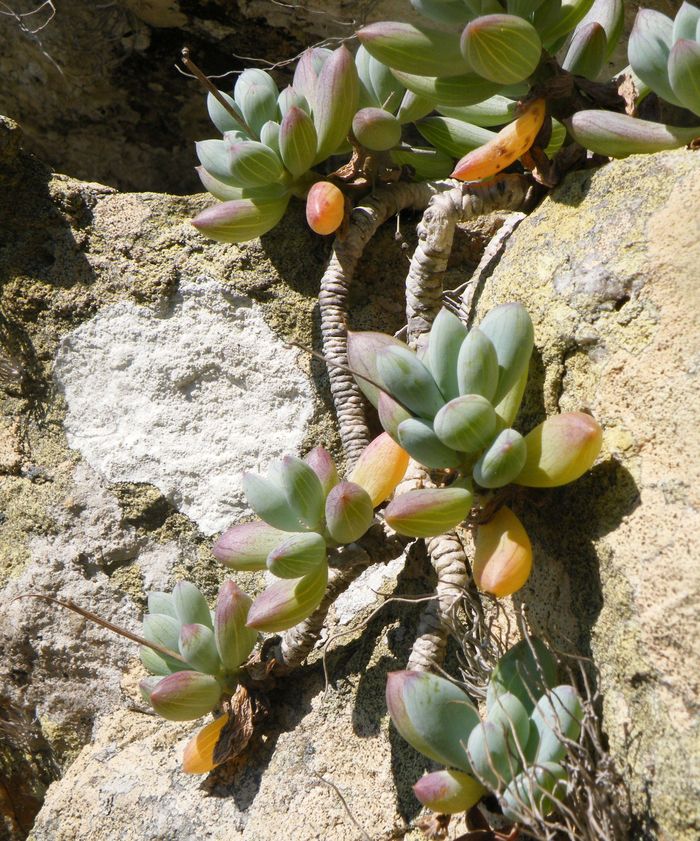
Inflorescence erect, terminal, sparingly branched and subcorymbose to rarely solitary, to 65–200 mm high, with few triangular-lanceolate bracts up to 5 mm long, discoid. Capitula with 10–14 phyllaries 12 mm long and about 6 mm in diameter. Disc florets 15–30, white; corolla lobes recurved. Achene hispid.
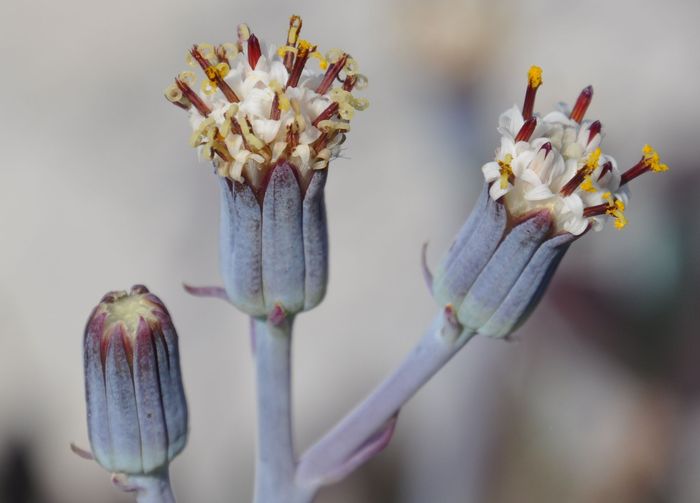
Flowering time is mainly in spring, summer and autumn, but sometimes at any time of the year.
Conservation Status
Status
Plants grow locally abundant, often in habitats difficult to reach. Widespread, well established in gardens and nurseries and consequently not threatened.
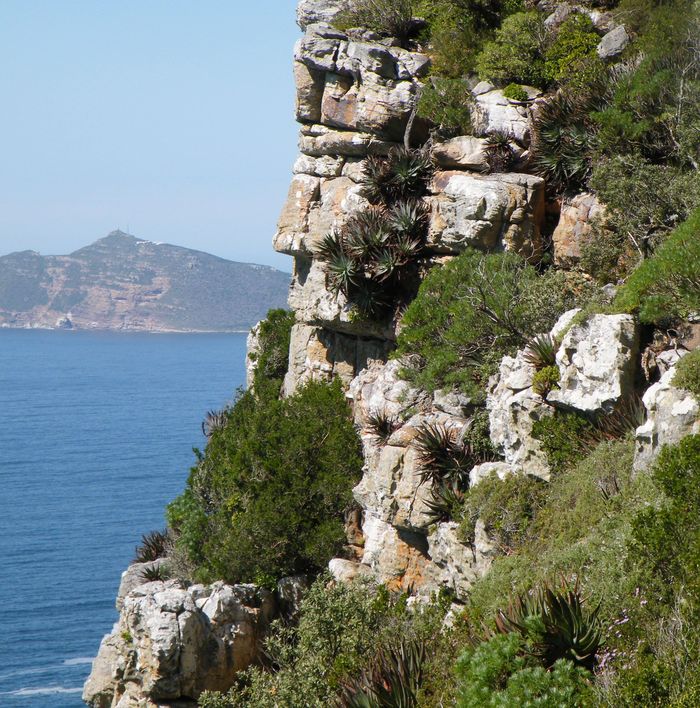
Distribution and habitat
Distribution description
Curio repens has been recorded in the Western Cape, from the Cape Peninsula in the west to Hermanus in the east, and also as far inland as the Simonsberg near Stellenbosch. The plants grow in rocky habitats and often on vertical quartzitic sandstone cliffs (all aspects) at altitudes of 10–1 000 m. Plants root in crevices, and on rock ledges, becoming drooping. Also sometimes seen on rocks close to the sea.

Temperatures in summer can be as high as 35ºC. Winters are cooler but frost is a rarity or absent. The average daily maximum temperature is 22ºC and the average daily minimum is 12ºC. Rainfall is mainly in winter and occasionally in summer, about 500–700 mm per annum. The plants grow in Peninsula Sandstone Fynbos of the Fynbos Biome (Mucina et al. 2006). At Chapmans Peak on the Cape Peninsula, it shares its habitat with other succulents such as Adromischus hemisphaericus, Aloe maculata, Cotyledon orbiculata var. orbiculata, Crassula lanceolata, C. nudicaulis and C. rupestris, Euphorbia caput-medusae and Lampranthus falciformis. The geology in its habitat consists of quartzitic sandstone, Peninsula Formation (Cape Supergroup).

Derivation of name and historical aspects
History
The plant was first named Cacalia repens by Carl Linnaeus in 1767, moved to the genus Kleinia by Haworth in 1812, then to Senecio by Jacobsen in 1951. It was transferred to the new genus Curio created by Paul Heath in the journal Calyx in 1999. Curio was established by Heath for the group of succulents, previously in Senecio, distinguished by having an evergreen nature, with elongated, striated, succulent leaves and discoid flower heads lacking ray florets. The genus name Curio means ‘to lean’ pertaining to many species with a leaning or decumbent habitat. The Latin species name repens, meaning ‘creeping’, pertains to its creeping nature. According to Rowley (1994) it was introduced to Europe in 1710. Another synonym for Curio repens is Senecio serpens G.D.Rowley.

Curio repens is related to both C. crassulifolius and C. talinoides. However, it is closer to the former, a much larger plant with much longer leaves. C. repens can easily be distinguished from both relatives by its shorter, often boat-shaped leaves, much shorter inflorescence but larger capitula, to about 12 mm long and 6 mm in diameter.
Ecology
Ecology
Curio repens grows on exposed, light coloured, quarzitic sandstone rocks and sheer cliff faces. The powdery bloom and bluish grey colour reflect the harsh sun, acting as a sun screen. The succulent nature enables the plant to survive periods of drought, when the leaves become very thin, only to revive after a rain shower. The orientation of the leaves is towards the sun, minimizing direct sun on the leaf blade.
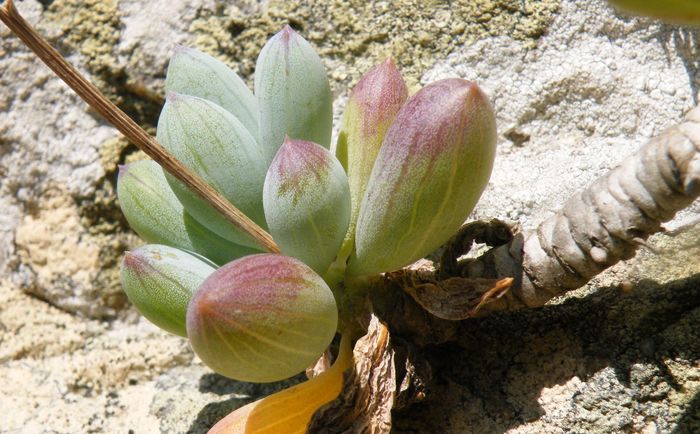
The cliff face is an ideal refuge, protecting the plants from larger herbivores. As with many associated succulents, branches which become detached and fall onto ledges, will root spontaneously when favourable conditions prevail. The plant also adjusts its leaf shape and size according to the habitat. When exposed and when growth place is limited, the leaves are short, boat-shaped (cymbiform) and the plant will also produce a shorter inflorescence. In a shadier or protected habitat, the stems and leaves will be elongated. The translucent veins in the leaf allows light penetration.
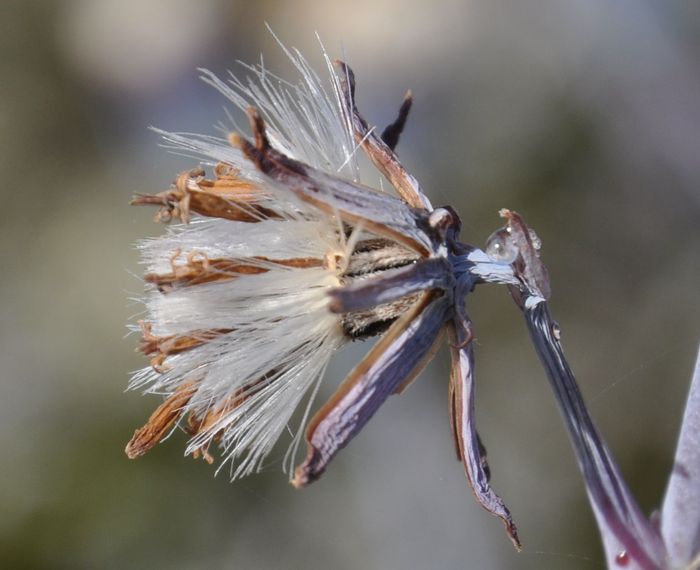
The downy seeds are dispersed by wind and under favourable conditions, seeds will germinate in suitable crevices.
Uses
Use
Apart from its horticultural use, no other uses have been recorded.

Growing Curio repens
Grow
Curio repens makes a wonderful ground cover in a water-wise garden. The striking, bluish, grey-green leaves are very decorative, and conspicuous when grown among other succulents. It is also suitable for steep embankments, window sills or balconies, thriving in containers. The plant is hardy to light frost. It is well established in the horticultural trade especially in Mediterranean-type climates of the world. Once established, it becomes a self-sustaining, long-lived perennial.
Curio repens requires a sunny, warm, well-drained position. Best planted in rockeries among companion succulents. In South Africa it is best grown in Fynbos and Succulent Karoo gardens (Van Jaarsveld 2010). Plants planted at Babylonstoren out of doors (winter rainfall area) have grown successfully, flowering in midsummer (January). Curio repens tolerates a wide range of soils and grows well in seafront and coastal gardens.
Plants are easily propagated by stem cuttings preferably taken in spring or summer. The cuttings can either be rooted first in sand or planted directly into the required position, but for successful establishment, should be kept moist. Curio repens plants are relatively slow growing.
References
- Clarke, H. & Charters, M. 2016. The illustrated dictionary of southern African plant names. Flora & Fauna Publications Trust, Jacana, Johannesburg.
- Eggli, U. (ed). 2001. Illustrated handbook of succulent plants: Dicotyledons. Springer, Berlin.
- Harvey, W.H. 1894. Compositae. In: W.H. Harvey & O.W. Sonder (eds), Flora capensis (Rubiaceae to Campanulaceae) III: 44–530. L. Reeve, Ashford.
- Heath, P.V. 1999. Three new generic names in the Asteraceae (part 2). Calyx 6(2): 54, 55.
- Linnaeus, C. 1767. Systema naturae per regnae tria naturae. Editio duodecima, reformata. Tomus 2 (Regnum vegetabile). Holmiae.
- Mucina, L. & Rutherford, M.C. (eds) 2006. The vegetation of South Africa, Lesotho and Swaziland. Strelitzia 19. South African National Biodiversity Institute, Pretoria.
- Rowley, G.D. 1994. Succulent compositae. Strawberry Press, Mill Valley, California.
- Van Jaarsveld, E.J. 2010. Water wise gardening. Struik, Cape Town.
Credits
Ernst van Jaarsveld
Kirstenbosch National Botanical Garden (Retired 2015)
Babylonstoren Farm
Extraordinary senior lecturer and researcher,
Department of Biodiversity and Conservation, University of the Western Cape
March 2020
Plant Attributes:
Plant Type: Ground Cover, Succulent
SA Distribution: Western Cape
Soil type: Sandy
Flowering season: Early Summer, Late Summer, Autumn, Sporadic/All year
PH: Acid, Neutral
Flower colour: White
Aspect: Full Sun, Morning Sun (Semi Shade), Afternoon Sun (Semi Shade)
Gardening skill: Easy
Special Features:
Horticultural zones








Rate this article
Article well written and informative
Rate this plant
Is this an interesting plant?
Login to add your Comment
Back to topNot registered yet? Click here to register.